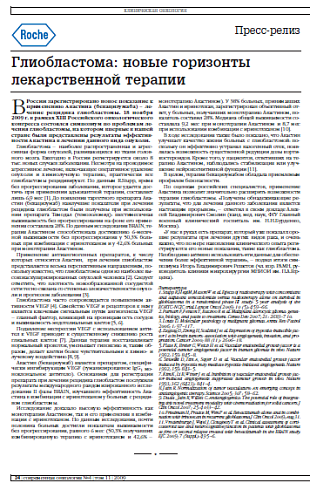Материалы доступны только для специалистов сферы здравоохранения.
Чтобы посмотреть материал полностью
Авторизуйтесь
или зарегистрируйтесь.
Глиобластома: новые горизонты лекарственной терапии
Глиобластома: новые горизонты лекарственной терапии
Материалы доступны только для специалистов сферы здравоохранения.
Чтобы посмотреть материал полностью
Авторизуйтесь
или зарегистрируйтесь.
Аннотация
Пресс-релиз
Полный текст
Список литературы
1. Stupp R, Hegi M, Mason W et al. Effects of radiotherapy with concomitant and adjuvant temozolomide versus radiotherapy alone on survival in glioblastoma in a randomised phase III study: 5-year analysis of the EORTC-NCIC trial. Lancet Oncol 2009; 10 (5): 459–66.
2. Furnari F, Fenton T, Bachoo R et al. Malignant astrocytic glioma: genetics, biology, and paths to treatment. Genes Dev 2007; 21: 2683–710.
3. Louis D. Molecular pathology of malignant gliomas. Annu Rev Pathol 2006; 1: 97–117.
4. Zagzag D, Zhong H, Scalzitti J et al. Expression of hypoxia-inducible factor 1a in brain tumors: association with angiogenesis, invasion, and progression. Cancer 2000; 88 (11): 2606–18.
5. Plate K, Breier G, Weich H et al. Vascular endothelial growth factor is a potential tumour angiogenesis factor in human gliomas in vivo. Nature 1992; 359: 845–8.
6. Shweiki D, Itin A, Soffer D et al. Vascular endothelial growth factor induced by hypoxia may mediate hypoxia-initiated angiogenesis. Nature 1992; 359: 843–5.
7. Kim K, Li B, Winer J et al. Inhibition of vascular endothelial growth factor-induced angiogenesis suppresses tumour growth in vivo. Nature 1993; 362 (6423): 841–4.
8. Jain R. Normalization of tumor vasculature: An emerging concept in antiangiogenic therapy. Science 2005; 307: 58–62.
9. Duda , Jain R, Willett C. Antiangiogenics: The potential role of integrating this novel treatment modality with chemoradiation for solid cancers. J Clin Oncol 2007; 25: 4033–42.
10. Friedman H, Prados M, Wen P et al. Bevacizumab alone and in combination with irinotecan in recurrent glioblastoma. J Clin Oncol 2009; Aug 31.
11. Vredenburgh J, Wefel J, Cloughesy T et al. Clinical assessment of corticosteroid use and neurocognitive function in patients with glioblastoma at first or second relapse treated with bevacizumab in the BRAIN study. EJC 2009; 7 (Suppl.): 495–6.
2. Furnari F, Fenton T, Bachoo R et al. Malignant astrocytic glioma: genetics, biology, and paths to treatment. Genes Dev 2007; 21: 2683–710.
3. Louis D. Molecular pathology of malignant gliomas. Annu Rev Pathol 2006; 1: 97–117.
4. Zagzag D, Zhong H, Scalzitti J et al. Expression of hypoxia-inducible factor 1a in brain tumors: association with angiogenesis, invasion, and progression. Cancer 2000; 88 (11): 2606–18.
5. Plate K, Breier G, Weich H et al. Vascular endothelial growth factor is a potential tumour angiogenesis factor in human gliomas in vivo. Nature 1992; 359: 845–8.
6. Shweiki D, Itin A, Soffer D et al. Vascular endothelial growth factor induced by hypoxia may mediate hypoxia-initiated angiogenesis. Nature 1992; 359: 843–5.
7. Kim K, Li B, Winer J et al. Inhibition of vascular endothelial growth factor-induced angiogenesis suppresses tumour growth in vivo. Nature 1993; 362 (6423): 841–4.
8. Jain R. Normalization of tumor vasculature: An emerging concept in antiangiogenic therapy. Science 2005; 307: 58–62.
9. Duda , Jain R, Willett C. Antiangiogenics: The potential role of integrating this novel treatment modality with chemoradiation for solid cancers. J Clin Oncol 2007; 25: 4033–42.
10. Friedman H, Prados M, Wen P et al. Bevacizumab alone and in combination with irinotecan in recurrent glioblastoma. J Clin Oncol 2009; Aug 31.
11. Vredenburgh J, Wefel J, Cloughesy T et al. Clinical assessment of corticosteroid use and neurocognitive function in patients with glioblastoma at first or second relapse treated with bevacizumab in the BRAIN study. EJC 2009; 7 (Suppl.): 495–6.
Авторы
Цель портала OmniDoctor – предоставление профессиональной информации врачам, провизорам и фармацевтам.

